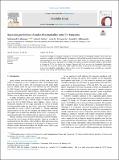| dc.contributor.author | Mwanga, Mohamed | |
| dc.contributor.author | Mirau, Silas | |
| dc.contributor.author | Tchuenche, Jean | |
| dc.contributor.author | Mbalawata, Isambi | |
| dc.date.accessioned | 2025-04-04T12:03:34Z | |
| dc.date.available | 2025-04-04T12:03:34Z | |
| dc.date.issued | 2025-01-26 | |
| dc.identifier.uri | https://doi.org/10.1016/j.fraope.2025.100221 | |
| dc.identifier.uri | https://dspace.nm-aist.ac.tz/handle/20.500.12479/3006 | |
| dc.description | This research article was published in the journal of Franklin Open, Volume 10, 2025 | en_US |
| dc.description.abstract | Under-five mortality is a burden on health and economic systems in developing countries. This study used
under-five mortality rate (U5MR) data for Tanzania from 1960 to 2020 to predict trends of under-five mortality
over the period of 2021 to 2051. Using a Bayesian state space model, it is found that the model is stable in
forecasting. Results show that under-five mortality will continue to decline from 48.9 in 2020 to 32.9 in 2030,
a decrease of 32.7%. But despite this decrease, Tanzania will likely not meet the Sustainable Development
Goal (SDG) for under-five mortality by 2030. Additional efforts by the government through evidence-based
interventions should be undertaken to improve child survival by expanding access to health care, especially
in rural areas, taking into account local context. | en_US |
| dc.language.iso | en | en_US |
| dc.publisher | Elsevier Inc. | en_US |
| dc.subject | Under-five mortality | en_US |
| dc.subject | State space model | en_US |
| dc.subject | Bayesian | en_US |
| dc.title | Bayesian prediction of under-five mortality rates for Tanzania | en_US |
| dc.type | Article | en_US |

